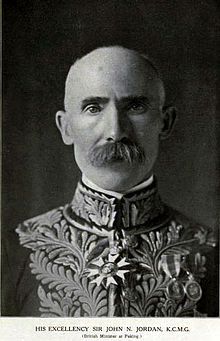
Summary
Sir John Newell Jordan GCMG GCIE KCB PC (5 September 1852 – 14 September 1925) was a British diplomat.
Sir John Jordan | |
|---|---|
 | |
| Envoy Extraordinary and Minister Plenipotentiary from the United Kingdom to the Qing Empire | |
| In office 19 September 1906 – 12 March 1910 | |
| Monarch | Edward VII |
| Preceded by | R.G. Townley |
| Succeeded by | William Grenfell Max-Muller |
| Envoy Extraordinary and Minister Plenipotentiary from the United Kingdom to the Republic of China | |
| In office 28 November 1910 – 1 March 1920 | |
| Monarch | George V |
| Preceded by | William Grenfell Max-Muller |
| Succeeded by | Sir Beilby Alston |
| Personal details | |
| Born | John Newell Jordan 5 September 1852 Balloo, County Down, Ireland |
| Died | 14 September 1925 (aged 73) |
| Alma mater | Royal Belfast Academical Institution Queen's College, Belfast Queen's College, Cork |
Early life and career edit
Jordan was born in Balloo, County Down, Ireland, the son of John Jordan, a wealthy Presbyterian farmer, and his wife Mary (née Newell). He apparently never lost his Ulster accent. He was educated at the Royal Belfast Academical Institution, Queen's College, Belfast[1] and Queen's College, Cork. At the age of 21, Jordan wrote to the Foreign office to consider his recruitment as he desired to be stationed at Japan as a diplomat for unknown reason.[2] In 1876 he joined the Chinese Consular Service as a student interpreter. He held various posts in South China before being appointed Chinese Secretary at the British Legation in Peking in 1891.
In 1896 he was appointed Consul-General at Seoul, Korea, becoming Chargé d'affaires in 1898 and Minister-Resident in August 1901.[3] He remained there until November 1905, being appointed Knight Commander of the Order of St Michael and St George (KCMG) in 1904. Jordan received the Queen Victoria Jubilee Medal in 1897 followed by the King Edward VII Coronation Medal in 1902.[1]
Ambassadorial career edit
In 1906 he was appointed HM Envoy Extraordinary and Minister Plenipotentiary to China as the successor to Sir Ernest Satow[4][5] and remained in the post until his retirement in 1920. He was appointed Knight Commander of the Order of the Bath (KCB) in the 1909 Birthday Honours and in 1910 received the Freedom of the City of Belfast at the same ceremony as the Scottish-American industrialist Andrew Carnegie.[6] Jordan was appointed Knight Grand Commander of the Order of the Indian Empire (GCIE) in 1911, and Knight Grand Cross of the Order of St Michael and St George (GCMG) in the 1920 Birthday Honours shortly after his retirement. He was also appointed to the Privy Council in 1915, entitling him to the style "The Right Honourable". In 1920, Jordan became a director of the Chartered Bank of India, Australia and China.[7]
Jordan, despite his retirement, was a delegate to the Washington Naval Conference of 1921–1922.
Personal life and family edit
In 1885, Jordan married Annie Howe Cromie (1849–1939), the eldest child of Dr Robert Cromie JP (1813–1901), the ruling elder of Clough Presbyterian church, a general practitioner and the local registrar of births and deaths, and his wife Ann Jane (née Henry; 1823–1899) of Ballyhosset, near Ardglass.
They had four children: three sons and a daughter. Dr John Herbert Jordan MC (1887–1949) was head of the Department of Public Health in Shanghai. Edith Mary Jordan (1890–1918) was married in 1911 to Lieutenant-General Sir Travers Clarke (1871-1962) and died in the flu pandemic seven years later. Robert Cromie "Bob" Jordan (1891–1966) worked as a young man in the Hong Kong and Shanghai Bank in Shanghai, before contracting polio.
Sir John and Lady Jordan were keen Sinophiles and collectors. Part of their extensive collection of ornate oriental carvings, jade, silver, ivories, textiles, porcelain, paintings and teapots was bequeathed to Bangor Borough Council by their son Bob and now form part of the collections of the North Down Museum.
Legacy edit
At his death he left estate valued at £39,409.[A][8]
Jordan Road in Hong Kong's Kowloon District is named after him.[9]
Notes edit
Footnotes edit
- ^ a b "Privy Councillors". Daily Record. British Newspaper Archive. 3 June 1915. Retrieved 4 August 2014.
- ^ Hirata 2013, p. 901.
- ^ "No. 27344". The London Gazette. 9 August 1901. p. 5256.
- ^ Robert Hart; James Duncan Campbell (1975). The I. G. in Peking: Letters of Robert Hart, Chinese Maritime Customs, 1868-1907. Harvard University Press. p. 1419. ISBN 978-0-674-44320-4.
- ^ "[Untitled]". Manchester Courier and Lancashire General Advertiser. British Newspaper Archive. 27 November 1920. Retrieved 24 July 2014.
- ^ "Mr. Carnegie Will Receive Freedom of Belfast". Evening Telegraph (Dundee). British Newspaper Archive. 26 September 1910. Retrieved 4 August 2014.
- ^ "Announcement". Aberdeen Journal. British Newspaper Archive. 27 November 1920. Retrieved 24 July 2014.
- ^ "Recent Wills". Aberdeen Journal. British Newspaper Archive. 6 November 1925. Retrieved 4 August 2014.
- ^ Jason Wordie (2007). Streets: Exploring Kowloon. Hong Kong University Press. pp. 60–61. ISBN 9789622098138.
- ^ MeasuringWorth.com
References edit
- Biography, Oxford Dictionary of National Biography
- . . Dublin: Alexander Thom and Son Ltd. 1923. p. – via Wikisource.
- Hirata, Koji (2013). "Britain's Men on the Spot in China: John Jordan, Yuan Shikai, and the Reorganization Loan, 1912–1914". Modern Asian Studies. 47 (3) – via JSTOR.


